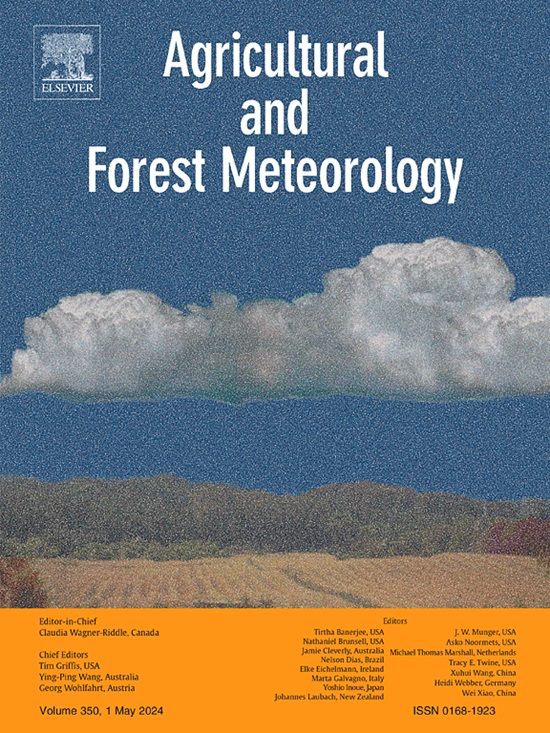温带阔叶林林隙边缘对阔叶林上层树液通量的影响
IF 5.7
1区 农林科学
Q1 AGRONOMY
引用次数: 0
摘要
树冠开口在小气候中产生梯度,可以增加树冠开口附近树木的蒸腾作用。本研究评估了成熟温带旱地阔叶林在建立0.1 ha和1 ha实验林隙3年和4年后的上层树木水分利用情况。利用热耗散探针对优势种群红枫(Acer rubrum)、山核桃(Carya spp.)、郁金香白杨(Liriodendron tulipifera)、白栎树和红栎树群(Quercus spp.) 63棵树的树液通量密度(Js)进行了测量,并随距离实验树冠间隙边缘(0 ~ 30 m)的增加而增大。日、日和季节分布均不随距林边距离的增加而变化,且林边树径的增加对林隙大小没有影响。Js在不同树种间普遍存在较高的树间变异,陡峭的斜坡和岩石土壤可能会加剧这种变异。不同树种间夏季j值差异明显,其中介介树种比栎、山核桃树种平均高43%。因此,林隙形成对混合阔叶林局地尺度水分有效性和林分尺度水分利用的短期影响将主要由林隙内小气候和植被动态之间的相互作用驱动,而不是由林隙边缘的冠层树木驱动。本文章由计算机程序翻译,如有差异,请以英文原文为准。
Canopy gap edge effects on overstory sap flux in a temperate mixed-hardwood forest
Canopy openings create gradients in microclimate and can increase transpiration of individual trees bordering the gaps. This study evaluates overstory tree water use in a mature, temperate, upland hardwood forest three and four years after the establishment of 0.1 and 1 ha experimental gaps. Sap flux density (Js) was measured using thermal dissipation probes in 63 trees of dominant species groups, red maple (Acer rubrum), hickory (Carya spp.), tulip-poplar (Liriodendron tulipifera), and white oak and red oak groups (Quercus spp.), with increasing distance from experimental canopy gap edge (0 – 30 m). Diurnal, daily, and seasonal patterns of Js showed no change with distance from gap edge and no difference between gap sizes, despite increased edge tree diameter growth. High tree-to-tree variability in Js was prevalent within species, potentially intensified by steep slopes and rocky soils. There were clear differences in summer Js between species with mesic species 43 % higher than oak and hickory species on average. As such, short-term effects of gap creation on local-scale water availability and stand-scale water use in mixed-hardwood forests will be largely driven by interactions between microclimate and vegetation dynamics within the gap, but not by canopy trees at the edge of the gap.
求助全文
通过发布文献求助,成功后即可免费获取论文全文。
去求助
来源期刊
CiteScore
10.30
自引率
9.70%
发文量
415
审稿时长
69 days
期刊介绍:
Agricultural and Forest Meteorology is an international journal for the publication of original articles and reviews on the inter-relationship between meteorology, agriculture, forestry, and natural ecosystems. Emphasis is on basic and applied scientific research relevant to practical problems in the field of plant and soil sciences, ecology and biogeochemistry as affected by weather as well as climate variability and change. Theoretical models should be tested against experimental data. Articles must appeal to an international audience. Special issues devoted to single topics are also published.
Typical topics include canopy micrometeorology (e.g. canopy radiation transfer, turbulence near the ground, evapotranspiration, energy balance, fluxes of trace gases), micrometeorological instrumentation (e.g., sensors for trace gases, flux measurement instruments, radiation measurement techniques), aerobiology (e.g. the dispersion of pollen, spores, insects and pesticides), biometeorology (e.g. the effect of weather and climate on plant distribution, crop yield, water-use efficiency, and plant phenology), forest-fire/weather interactions, and feedbacks from vegetation to weather and the climate system.

 求助内容:
求助内容: 应助结果提醒方式:
应助结果提醒方式:


